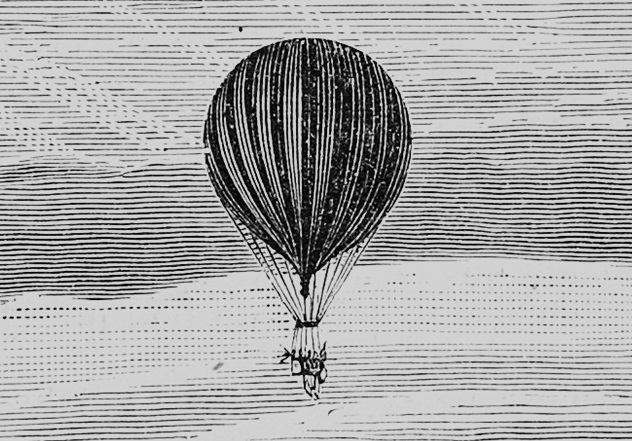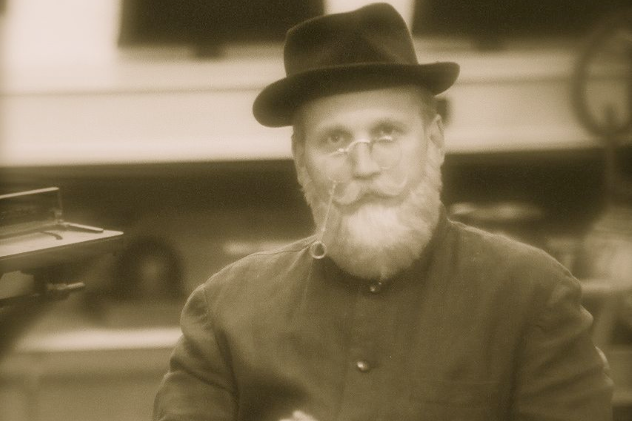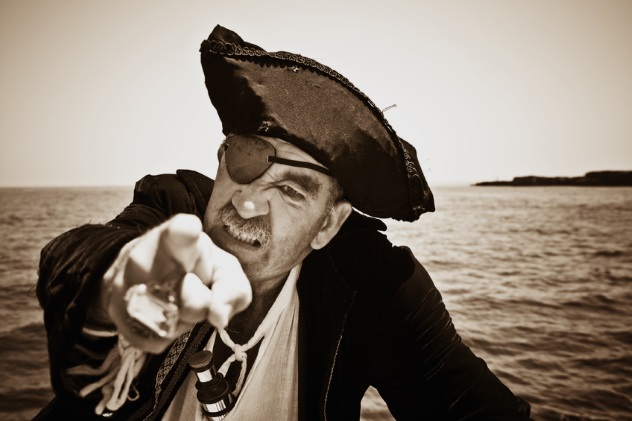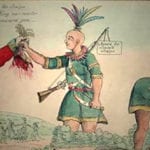10 ‘Furvin Kryakutnoy’
Fans of Monty Python know that the Montgolfier brothers kick-started the age of flight when they launched their hot-air balloon in 1783, proving that living creatures could safely head up into the wild blue yonder. For decades, the Russians firmly believed that they had beat the French to it by nearly 50 years. In the 19th century, a Russian forger named A. Sulukadzev wrote about the exploits of Furvin Kryakutnoy of Nerekhta. The fictitious inventor was supposedly the true creator of the hot-air balloon, having developed his mode of airborne travel in the early 18th century. The story was widely accepted into Russian history, so much so that in 1956, the Russian government released a commemorative stamp recognizing the 225th anniversary of Kryakutnoy’s historic flight. The stamp was released around the same time that Russia was undergoing a surge of nationalism and pride, and they even gave the fictional inventor his own entry in the Great Soviet Encyclopedia. The myth held until 1981, when the truth finally came out in a publication called Voprosy literatury.
9 ‘Lucy Lightfoot’
Gatcombe is a small village and parish on the Isle of Wight, and it is home to a church that was built in 1292. Financed by the Estur family, the church honors one of their own—Edward, a knight who left home for the Crusades. For centuries, the church was home to a wooden effigy of Edward. In the early years of the 19th century, the village was also home to a girl named Lucy Lightfoot. Lucy would spend hours in the church, and when her family asked her why, she replied that she had fallen in love with the image of the knight and spent her days imagining that she was going on adventures and traveling the world at his side. Then, on June 13, 1831, Lucy disappeared. A brutal thunderstorm had swept through the area along with a total eclipse of the Sun. After the storm abated and the solar eclipse ended, Lucy’s horse was found waiting at the church gates. She was nowhere to be seen. Fast-forward a few decades to 1865 and the Reverend Samuel Trelawney. Trelawney was researching the Crusades and stumbled across a document penned in 1365 by the chancellor to the king of Cyprus. The manuscript told the story of a valiant knight named Edward Estur, who traveled with the company of his love, Lucy Lightfoot. They were ultimately separated by battle, and Edward suffered a head wound that caused him to forget how much he loved his young companion. Did Lucy’s pure, young love open up a portal that allowed her to step back through time to join the object of her affection? Or was the entire story the invention of a 20th century rector who hoped to tell a great story and earn some cash for the church’s coffers in the process? Lucy’s creator was named James Evans, and the vicar ultimately confessed to making the whole thing up.
8 ‘H. Rochester Sneath’
In 1948, public figures, particularly school headmasters, began to receive bizarre letters in the mail. They were sent from H. Rochester Sneath, who identified himself as the headmaster of a school called Selhurst. None of the letters’ recipients had ever heard of the school or the person, but that didn’t stop a number of them from replying to the letters’ outrageous claims and accusations. The headmaster of a Northamptonshire school was asked for advice on how to deal with a rat problem, and Sneath asked the headmaster of Marlborough College how he’d “managed to engineer” a visit recently from the King and Queen. That letter was followed up by one warning the headmaster of a (fictional) applicant for the position at Marlborough. Sneath warned against hiring him, saying that he had once given three matrons a nervous breakdown and that he had, on one occasion, been caught doing some naked tree-climbing. There was a huge amount of letters making the rounds, including another to the newly appointed headmaster at Rugby, which expressed Sneath’s sincere hope that he would avoid the fate of one of Selhurst’s headmasters (who had committed suicide after eloping with a matron). George Bernard Shaw received a letter asking him to give a speech at Selhurst’s 300th anniversary celebration (he refused), but an artist who was approached and asked to design a statue of the school’s founder, Ebenezer Okeshot, was quite open to the possibility. The man behind Sneath was an undergrad at Cambridge University named Humphrey Berkeley. Berkeley, who was discovered after writing to The Daily Worker and complaining that Selhurst didn’t teach Russian, went on to become a Conservative minister of Parliament only 11 years after he was issued a formal rebuke from the school.
7 ‘Johann Dieter Wassmann’
Take a look at the Wassmann Foundation’s website, and you will find absolutely nothing amiss. The director’s message says that the foundation was formed with the goal of bringing the work of Johann Dieter Wassmann to the world. Wassmann, the site says, born in 1841 in Leipzig, Germany. He was a sewer engineer and the son of a carpenter. He took the knowledge that his father has passed down to him and created a massive body of strangely unique pieces. His work, presented in wooden crates, were designed to reflect the thoughts and fears that developed as he looked at the rapidly changing world around him. Wassmann died in 1898 after a tragic accident. He slipped and fell while boarding a train, and the carriage severed his leg at the knee. A few months later, he passed away from his injuries The outsider artist was the creation of another artist, Jeff Wassmann. According to Jeff, the idea started with the artwork itself. Originally having planned to write a series of short stories that traced the life of Johann Wassmann through the 19th century, the present-day Wassmann soon realized that his character and his artist were one and the same. The site, the foundation, and the exhibitions all grew out of that. While the creators behind the ill-fated artist originally kept their names off everything associated with him, an exhibition at the Melbourne Festival requested that the truth be told to its audience.
6 ‘The Honorable J. Fortescue’
The man known as J. Fortescue had an illustrious career that anyone would be jealous of. Born in 1868, he had a handful of degrees and wrote a massive catalog of medical articles on everything from polio to the sex habits of the American male to surveying the hygiene practices of numerous Mexican restaurants. He also founded the International Board of Hygiene, which was not only well-received, but endorsed by the League of Nations. Fortescue was, of course, not a real person. He was the creation of a San Diego pathologist named Dr. Rawson Pickard. Pickard and his companions, mostly medical professionals as well, wanted to create an organization that would ultimately be responsible for unifying the world in the matters of public health. That sounds like a fine and respectable goal, but in the interest of full disclosure and clarification, the first (and subsequent) meetings of the new society were held in an establishment called the Turf Bar in Tijuana. The gathered professionals agreed to serve on the board, but they needed a president. Pickard suggested using the name of an English jurist who had died in 1476, and the Honorable J. Fortescue was elected by a landslide. Since their meetings were always held outside of the US (still in Tijuana), they needed an international charter to make their organization legit. Letters sent to the Department of Public Health in San Diego and then to the League of Nations met with approval, and J. Fortescue was at the head of an international organization. To keep up appearances, Pickard wrote scores of articles as Fortescue and gave him a 30-year career. Anyone who wanted to speak with him conveniently went through Pickard, who kept the entire thing going with impressive-sounding updates about what Fortescue was currently doing or planning next. He was even approached by the National Research Council, which was doing some fact-checking for their directory on child psychologists. He was included, and not long after, he was even awarded with a $10,000 check for his entry in a letter-writing contest called “Why I Eat Fleischmann’s Yeast.” (It was good for pimples.) Fortescue continued to show up in countless scientific and medical journals until 1963, when both Pickard—and Fortescue—died.
5 ‘Josiah Carberry’
In 1929, a strange notice was posted on a bulletin board at Brown University. It was advertising a lecture that would be given by J.S. Carberry, who would be talking about archaic Greek architectural Revetments in connection with Ionian philology. It sounded unlikely enough, but anyone interested in more information was told to contact another professor, John Spaeth. Spaeth told anyone who asked about Carberry all about his “ungrammatical” wife, his “poetical” daughter, and his other daughter, who hunted puffins. Carberry also had an assistant, who was often bitten by things with names that started with the letter “A.” Gradually, Carberry’s name started to show up on local press releases and eventually in scholastic journals. His book, Psychoceramics (a study on cracked pots), was cited in American Scientist. The New York Times called him the world’s greatest traveler, and his work in the field of cracked pots even earned him an Ig Noble Prize. In 1955, the university received a donation of $101.01 from Carberry to start the Josiah S. Carberry Fund, which is still going today. The fund specified that on every Friday the 13th, students and alumni would pool their loose change for donations to the fund, which would then be used to buy books that Carberry would (or wouldn’t) like. The fund has purchased a huge number of books, like Michael Cardew’s The Last Sane Man: Modern Pots, Colonialism and the Counterculture.
4 ‘Edward Owens’
In 2008, a new blog (one of a million) popped up on the Internet. The subject of the blog was a man named Edward Owens, who was being researched by the blog’s owner for a college project. Over the next few months, Jane Browning detailed her search for more information on the man she called “the Last American Pirate,” and she found a good amount of proof that he was more than just a local legend. She interviewed experts, made YouTube videos of abandoned locations that were supposedly tied to Owens, and even got an entry on him created on Wikipedia. Jane even claimed to have stumbled across his last will and testament and uploaded photos of the document to the blog. The tales of the pirate who had once patrolled the Chesapeake Bay area were, for the most part, bought hook, line, and sinker. A blurb about the recently discovered Owens even showed up in USA Today . . . until they realized that Owens wasn’t real. He was the creation of students in a class at George Mason University called Lying About the Past. The point of the class was to study how easily the truth grows and changes on the Internet. Academic study or not, Wikipedia founder Jimmy Wales called them out on it and likened their actions to digital vandalism. When the next class tried their hand at creating their own bogus pieces of history, they weren’t as successful as the story of Edward Owens had been.
3 ‘Sidd Finch’
April 1, 1985, was a cover date for Sports Illustrated, so George Plimpton was given the freedom to write absolutely anything he wanted to in order to commemorate the date. The result was a 14-page spread on a baseball phenomenon named Sidd Finch, and Plimpton’s story was so outrageous that it was completely believed. Sidd Finch was an orphan from England who moved to Tibet in his bid to become a monk. It was there that he learned the art of meditation, which allowed him to throw a baseball a staggering 270 kilometers per hour (168 mph)! He was signed by the Mets and brought to the States in the shadow of secrecy. Some serious prep work went into the story ahead of time, with a man named Joe Berton being cast to play the mysterious new pitcher. He was given an official uniform and an all-access pass to the Mets training complex. Only a handful of people there were aware of what was going on. He always had his French horn with him, and when he pitched, it was with one bare foot and one clad in a work boot. When the story broke, the reaction was instant. Papers across New York were mad that they had been scooped. Commissioners debated the safety issues now facing players standing at the plate and trying to hit a ball going that fast. Meanwhile, Berton was back home, teaching art at a high school. Finally, someone realized that the first letters in the words of a secondary headline in the Finch story spelled out “Happy April Fools’.” Decades later, baseball fans still wait for the real Sidd Finch, while Berton cherishes the time that his own baseball dreams came true.
2 ‘Ernst Bettler’
Ernst Bettler exists as a cautionary tale to both designers and those who employ them. The story says that in the 1950s, a Swiss pharmaceutical company called Pfafferli+Huber hired Bettler to design some new advertising for them. Bettler went on record as saying that he knew the company had a less-than-stellar record when it came to human rights and that they had been implicated as being a part of the medical testing done on prisoners in Nazi concentration camps. Bettler decided that they shouldn’t be allowed to forget what they had done—and that no one else should forget, either. He designed a series of four posters, and when they were looked at individually, they looked like nothing more or less than the typical full-page ads of the era. When the different posters were displayed together in a particular order, however, the black-and-white, almost abstract images on them spelled out “N-A-Z-I.” The public was outraged, the company’s war crimes were made common knowledge, and they were bankrupt in six weeks. The art community bought the story in full when it appeared in a 2000 issue of Dot Dot Dot, but it was, of course, not true. The invention of designer and writer Christopher Wilson, Bettler and his heroic tale even made it into an art and design textbook. He was hailed as one of the first to use design to not only send a message, but to make sure that justice was carried out.
1 ‘Andreas Karavis’
The first time that Andreas Karavis and his work were introduced to the world was in a 1999 article in Books in Canada, where he was called the “modern-day Homer.” The mysterious, reclusive poet had befriended a much more outgoing man named David Solway, who acted as his translator. Karavis was a Greek fisherman who had been born in 1932 and whose first book had supposedly elevated him to the very pinnacle of modern Greek literature. It was only after years of friendship that Karavis reportedly allowed Solway to translate his poetry and introduce it to an English-speaking audience. The first article that ran on Karavis was worded to give no doubts as to the veracity of the story. Unfortunately, Solway’s diligence in creating a background story for his fictional poet led to the discovery of not just cracks in the tale, but chasms. One Hellenist translator took a closer look at what had been written about the poet and found that it was likely that there was more to him than met the eye. He claimed that Karavis was a smuggler who had falsified documents to get his work published, while another researcher found that the earliest pieces of poetry had been pirated from other sources. One of the people whose work had been ripped off? David Solway. Solway let some of his critics in on the con and continued to publish around 80 pages of poetry and 20 more pages of commentary. Fans claimed Karavis to be worthy of a Nobel Prize. The poet even made a brief appearance at his own book launch, although Solway would later admit that the man was actually his dentist. Solway later claimed that he had not meant any harm by the hoax and that he saw it as an opportunity to wake his fellow Canadians up to something new. In a completely unflattering sentiment, he said, “Canadians are not a very exciting people. Like rubes at a carnival, they need to be poked, challenged, gulled, bedazzled, so that the collective jaw drops in something other than an insufficiently stifled yawn.” Read More: Twitter























